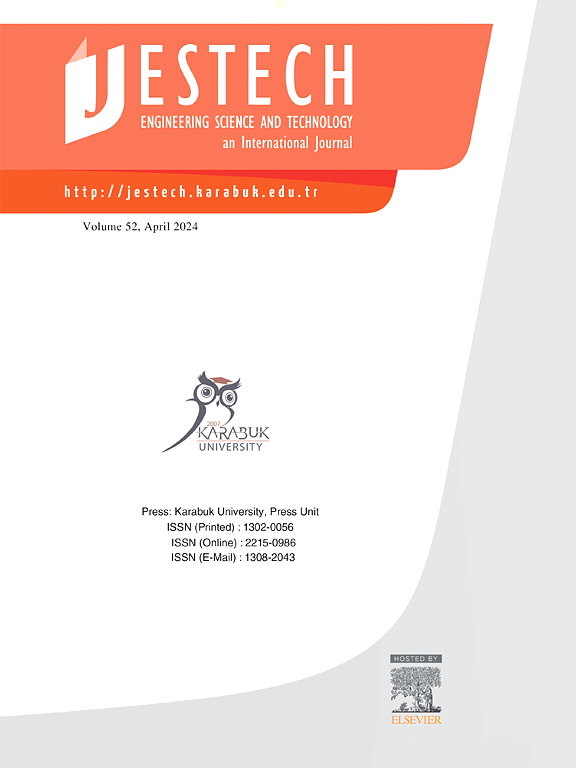基于gis的Yalova中部滑坡易感性制图:AHP、FMEA和Pareto系统分析
IF 5.4
2区 工程技术
Q1 ENGINEERING, MULTIDISCIPLINARY
Engineering Science and Technology-An International Journal-Jestech
Pub Date : 2025-02-21
DOI:10.1016/j.jestch.2025.102013
引用次数: 0
摘要
亚洛瓦地区因其气候、地形、地理特征和地质构造等因素,是滑坡危险性较高的地区。由于该地区的山体滑坡造成的物质和精神损失,对绘制山体滑坡易感性图和风险管理至关重要。本研究旨在利用层次分析法(AHP)、失效模式与效应分析法(FMEA)和帕累托系统分析法(Pareto System Analysis),绘制基于地理信息系统(GIS)的亚洛瓦中部地区滑坡易感性图(LSM)。分析中使用了岩性、坡度、坡向、与道路的距离、NDVI(归一化植被指数)、与断层的距离、土地利用、降雨量、与河流的距离和海拔等因素。采用FMEA、Pareto和AHP方法,以综合顺序的方式确定LCF权重。根据分析,岩性是影响最大的因素,占29.5%的权重最大,而外观占1.5%的权重最小。通过处理所制备的lcf中的权重值生成LSM。根据绘制的滑坡易感性图,将研究区划分为极低风险29.60%、低风险29.51%、中度风险24.04%、高风险13.18%、极高风险3.68%。根据滑坡危险性类别进行区域规划,并提前确定相应的防范措施。将生成的LSM与现有库存进行比较,确定该地区95.29%的以前发生的滑坡位于LSM上的危险区域。结果证明了AHP、FMEA和Pareto方法的综合适用性,并提供了比单一方法更准确的lcf权重。本研究采用的方法可以很容易地适应不同的地区,不仅可以用于滑坡分析,也可以用于其他学科的风险评估研究。本文章由计算机程序翻译,如有差异,请以英文原文为准。
GIS-based landslide susceptibility mapping using AHP, FMEA, and Pareto systematic analysis in central Yalova, Türkiye
Yalova is a region with high landslide risk due to its climate, terrain, geographical features, and geological structure. Landslides in the region are of critical importance to produce landslide susceptibility maps and risk management because of the material and moral damage they cause. This study aimed to produce a Geographic Information System (GIS)-based landslide susceptibility map (LSM) of the Yalova central region using the Analytic Hierarchy Process (AHP), Failure Mode and Effect Analysis (FMEA), and Pareto systematic analyses. Lithology, slope, aspect, distance from roads, NDVI (Normalized Difference Vegetation Index), distance from faults, land use, rainfall, distance from rivers, and elevation factors were used in the analyses. The FMEA, Pareto, and AHP methods were used in an integrated and sequential manner to determine the LCF weights. According to the analysis, lithology was identified as the most influential factor, with the highest weight at 29.5%, while appearance had the lowest weight at 1.5%. The LSM was generated by processing the weight values in the prepared LCFs. Based on the produced landslide susceptibility map, the study area was categorized as having 29.60% very low-risk, 29.51% low-risk, 24.04% moderate-risk, 13.18% high-risk, and 3.68% very high-risk. Regional planning should be undertaken according to the landslide risk categories, and appropriate measures should be determined for each level in advance. Upon comparing the produced LSM with the existing inventory, it was determined that 95.29% of the previously occurring landslides in the region were in risky areas on the LSM. The results demonstrate the integrated applicability of the AHP, FMEA, and Pareto methods and provide a more accurate weighting of LCFs compared to a single method. The approach used in this study can be easily adapted to different regions and can be used not only for landslide analysis but also for risk assessment studies in other disciplines.
求助全文
通过发布文献求助,成功后即可免费获取论文全文。
去求助
来源期刊

Engineering Science and Technology-An International Journal-Jestech
Materials Science-Electronic, Optical and Magnetic Materials
CiteScore
11.20
自引率
3.50%
发文量
153
审稿时长
22 days
期刊介绍:
Engineering Science and Technology, an International Journal (JESTECH) (formerly Technology), a peer-reviewed quarterly engineering journal, publishes both theoretical and experimental high quality papers of permanent interest, not previously published in journals, in the field of engineering and applied science which aims to promote the theory and practice of technology and engineering. In addition to peer-reviewed original research papers, the Editorial Board welcomes original research reports, state-of-the-art reviews and communications in the broadly defined field of engineering science and technology.
The scope of JESTECH includes a wide spectrum of subjects including:
-Electrical/Electronics and Computer Engineering (Biomedical Engineering and Instrumentation; Coding, Cryptography, and Information Protection; Communications, Networks, Mobile Computing and Distributed Systems; Compilers and Operating Systems; Computer Architecture, Parallel Processing, and Dependability; Computer Vision and Robotics; Control Theory; Electromagnetic Waves, Microwave Techniques and Antennas; Embedded Systems; Integrated Circuits, VLSI Design, Testing, and CAD; Microelectromechanical Systems; Microelectronics, and Electronic Devices and Circuits; Power, Energy and Energy Conversion Systems; Signal, Image, and Speech Processing)
-Mechanical and Civil Engineering (Automotive Technologies; Biomechanics; Construction Materials; Design and Manufacturing; Dynamics and Control; Energy Generation, Utilization, Conversion, and Storage; Fluid Mechanics and Hydraulics; Heat and Mass Transfer; Micro-Nano Sciences; Renewable and Sustainable Energy Technologies; Robotics and Mechatronics; Solid Mechanics and Structure; Thermal Sciences)
-Metallurgical and Materials Engineering (Advanced Materials Science; Biomaterials; Ceramic and Inorgnanic Materials; Electronic-Magnetic Materials; Energy and Environment; Materials Characterizastion; Metallurgy; Polymers and Nanocomposites)
 求助内容:
求助内容: 应助结果提醒方式:
应助结果提醒方式:


